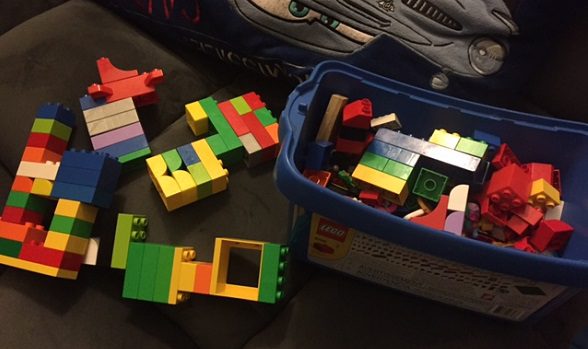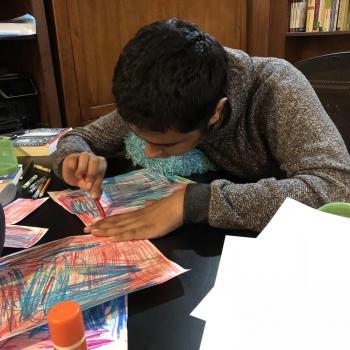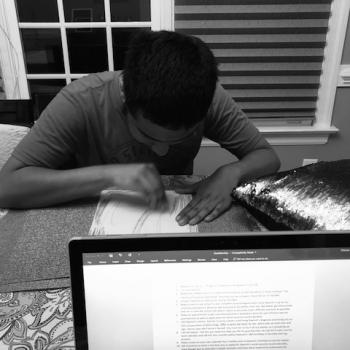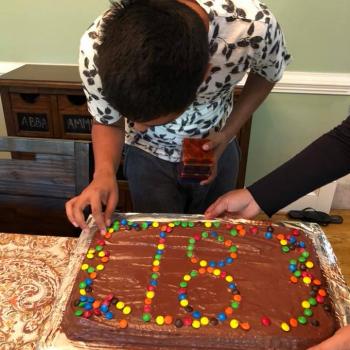
Ali Family Autism Truths #18 – April 18, 2016
More than twelve years ago, a series of evaluations and research had led us to a life changing moment: We sat in an office at Beth Israel Hospital in New York City, waiting for the head of the Behavior Developmental Pediatrics department to talk to us. She had done a series of evaluations on D and had consulted with his pediatrician and us.
Soon, she ushered my husband, D and myself into her office. My mother-in-law sat with baby A, then barely a few weeks old, outside.
We heard the words “pervasive deficit disorder,” “autism,” applied behavioral analysis” and a bunch of other things that I wrote down but didn’t make sense to me.
Because really, all I could see was three-year-old D.
Sitting on a little chair, at a little table, stacking Lego blocks. Up, up, up in a single block tower formation.
Next to him were other block combinations. I knew she had asked him to make the same simple block formations that she made as part of her testing.
He kept building the same single block tower formation.
Up, up, up.
D went to bed tonight after a full day of school, therapy and everything else under the sun. I was gone most of the day at a meeting, and when I returned late in the day, all the kids came and gave me hugs, D included. Later on he retreated to his bedroom, and I heard the click-clack of Lego blocks being put together.
About a year ago my mother-in-law found an old plastic carton of our medium-sized Lego blocks, the ones D played with years ago and which H played with as a toddler as well. She presented them to D, thinking it may be a soothing activity for him to do before bedtime, when he is sans beads and looking for something to occupy his hands.
Now the tub of blocks sits permanently in his room, and often we hear the click-clack of stacking blocks as he winds down for the night. When the clicking noises grew quiet, I knew he was fully sleepy. I went up and helped him get settled in bed.
And that’s when I saw the blocks on the chaise lounge in his room. All sorts of colors, all sorts of formations. Not a stack of single blocks going up, up, up. But a variety of combinations and colors, shapes and sizes.
Easy has never been the word I’d use to describe D. Nothing has ever come easy for him, except trusting and loving. The challenges and struggles D’s faced have seemed insurmountable at times and cosmically unfair and wrong. Things no child, no person should have to endure. And, in all the essays and literature I’ve read by autistic people, as much as I realize how much autistic self-advocates are frustrated with the negative doom-and-gloom narratives and want to drive their own narratives (as well as they should), I’ve harbored my fair share of frustration and negativity towards D’s autism and the difficult ways D’s autism has manifested over the years.
Not D, but autism. And I know that sound’s odd, because D’s autism is part and parcel of him. And so, as many have argued, to harbor frustration towards D’s autism is to harbor frustration towards him.
No.
The truth is, for us at least, it’s more complicated than that. Maybe that’s wrong of us, but in documenting the Ali Family Autism Truths, I have to be honest. It is just complicated. It has always been complicated.
It has also always been surprising and fluid. Never static, never rigid. Routines and rituals, yes. But never so rigid as to keep D frozen in one spot or in one repeat cycle. Where the up, up, up of the Lego block formations have given way to abstract forms and patterns, 12 years later.
Who knows? Maybe in another 12 years he’ll be making buildings. Maybe there is an architect brewing in him, like his paternal grandfather. The mind is a mystery unfolding on its own schedule, on its own terms.
Stay in touch! Like Muslimah Next Door on Facebook:











